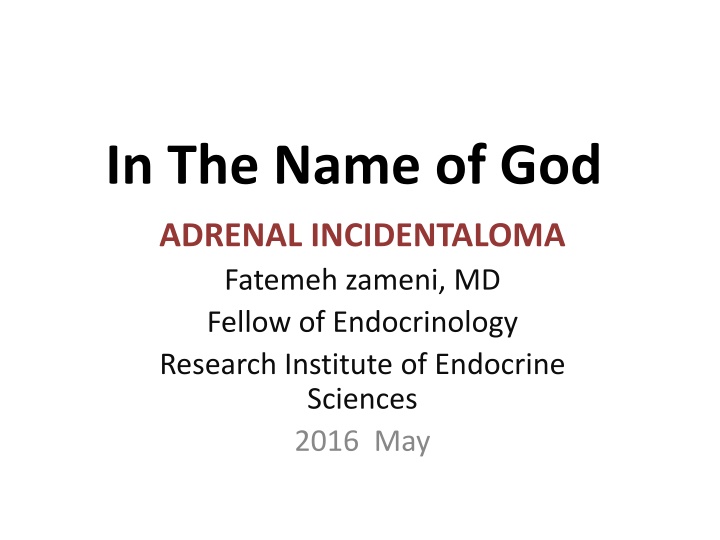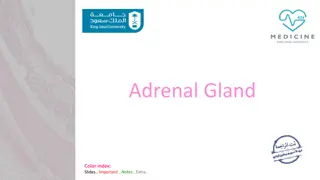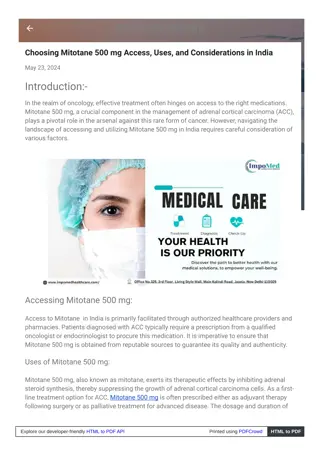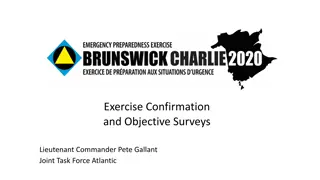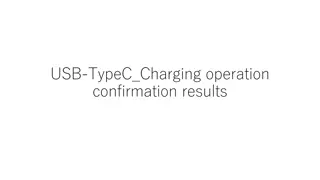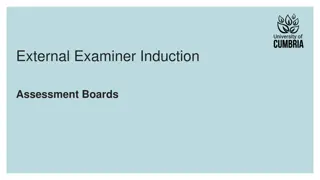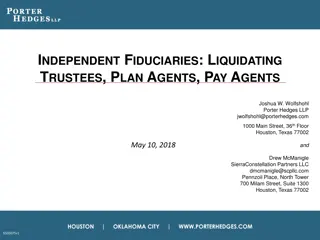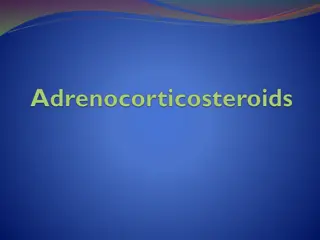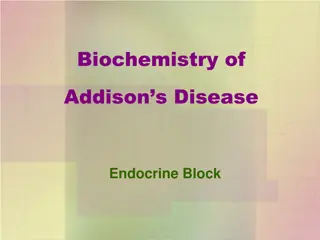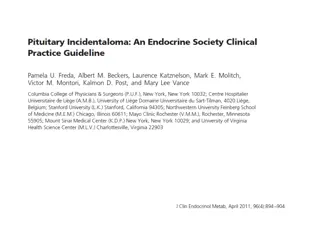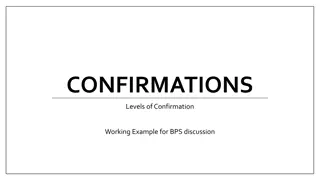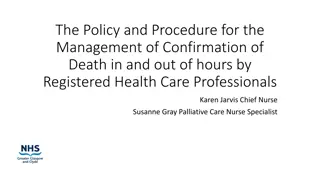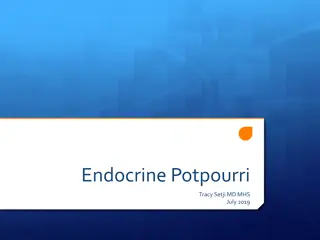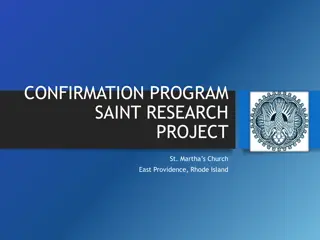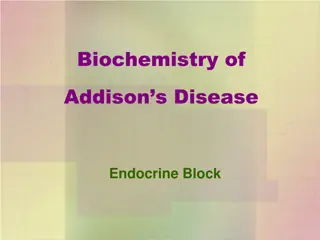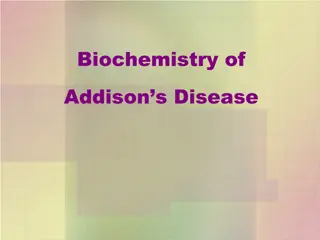Adrenal Incidentaloma: Etiology, Assessment, and Case Confirmation
Adrenal incidentaloma refers to the incidental detection of adrenal lesions unrelated to adrenal disease. Explore the etiology, diagnostic assessment, and case confirmation procedures for this condition, including imaging studies, hormonal evaluation, and subtype classification methodologies. Learn about ARR cut-off values, SIT testing, and ancillary tests like adrenal CT scan and adrenal venous sampling.
Download Presentation

Please find below an Image/Link to download the presentation.
The content on the website is provided AS IS for your information and personal use only. It may not be sold, licensed, or shared on other websites without obtaining consent from the author.If you encounter any issues during the download, it is possible that the publisher has removed the file from their server.
You are allowed to download the files provided on this website for personal or commercial use, subject to the condition that they are used lawfully. All files are the property of their respective owners.
The content on the website is provided AS IS for your information and personal use only. It may not be sold, licensed, or shared on other websites without obtaining consent from the author.
E N D
Presentation Transcript
In The Name of God ADRENAL INCIDENTALOMA Fatemeh zameni, MD Fellow of Endocrinology Research Institute of Endocrine Sciences 2016 May
ADRENAL INCIDENTALOMA Adrenal incidentaloma refers to the casual detection of an adrenal lesion during imaging performed for reasons unrelated to adrenal disease.
Assessment of the Patient with Adrenal Incidentaloma Imaging Studies: 1-Size 2- Hounsfield units 3-Washout Hormonal Evaluation : 1-Pheochromocytoma 2- Primary aldosteronism 3-Cushing s syndrome 2015
Our Case: ARR = 235.5
Case Confirmation: Four testing procedures:(No gold standard) 1. Oral sodium loading test 2. Saline infusion test (SIT) 3. Fludrocortisone suppression test 4. Captopril challenge test *Choice: cost, compliance, lab routine, local expertise
SIT: Lack powerful study designs for establishing the test accuracy Sensitivity: 83-88% Specificity: 75-100%
Our Case: SIT: Start End PAC (ng/dL) 75.8 70.9 PRA (ng/mL/h) 0.33 0.39 Cortisol (micg/dL) 5.86 5.65 Potassium (mg/dL) 3.9 3.5 PAC/Cortisol 12.9 12.5
Subtype Classification: Adrenal CT scan Adrenal venous sampling (AVS): If surgical treatment is practicable and desired by the patient To distinguish between unilateral and bilateral adrenal disease Ancillary tests
Adrenal CT Scan: APA: usually < 2 cm, hypodense nodule IHA: normal-appearing or unilateral or bilateral nodular changes Aldosterone-producing adrenal carcinomas: almost always > 4 cm and with suspicious imaging phenotype Sensitivity: 48-58%; Specificity: 90% Several Limitations especially in older patients (>40 yr), thus: AVS is essential to direct appropriate therapy
Our Case: Adrenal CT scan: A 38 mm mass with small central calcification of right adrenal. HU in precontrast : 12 HU in portal phase : 80 HU in delay phase : 40 Absolute wash out : 66%
Unsuccessful or unavailable AVS: 1) Repeat AVS 2) Treat with MR antagonist 3) Consider surgery based on the other studies: Adrenal CT Scan Posture Stimulation Test Morning Recumbent 18-OHB levels Not available Low accuracy
Posture Stimulation Test: The absence of the significant increase (<30%) of PAC at the upright posture supports the diagnosis of APA Test accuracy: 85% Fontes RG, Am J Hypertens 1991;4:786-91 Young WF, Endocrinol Metab Clin North Am 1988;17:367-95 The fall in PAC during 4 h erect posture has PPV of 100% for diagnosis of unilateral lesion Espiner EA, J Clin Endocrinol Metab 2003;88:3637-44
Our Case: Posture Stimulation Test: overnight recumbent 2 h ambulation PAC (ng/dL) 87.0 75.8 PRA (ng/mL/h) 0.32 0.33 PAC increase: - 11.2 ng/dL ( - 12 %)
Summary of Diagnostic Studies: ARR = 235.5 ng/dL per ng/mL/h Post-SIT PAC= 70.9 ng/dL Post-SIT PAC/Cortisol= 12.5 ng/dL per micg/dL (in favor of APA) Positive posture stimulation test (in favor of APA) An adenoma on CT scan
Diagnosis Aldosterone-producing Adenoma
The Concept of Subclinical Cushing s syndrome(SCS) The presence of one or more abnormalities in cortisol secretion in patients who do not present features of overt Cushing s syndrome. Prevalence : 1% to 47% Higher in bilateral lesions
Diagnosis Cortisol level < 1.8micg/dL after 1 mg dexamethasone clearly exclude autonomous cortisol secretion. Cortisol levels >5 micg/dL likely indicate SCS if no interfering conditions are present. Cortisol level 1.8 - 5 micg/dL DST be considered as indeterminate. 22
When the results of the 1-mg DST are undefined ,SCS may be definitively demonstrated with additional work-up, i.e. measurement of ACTH, UFC or late-night salivary cortisol. We are not using adrenal scintigraphy anymore to detect autonomous cortisol secretion because this test causes a high radiation exposure 23
What work-up should be performed for subclinical hypercortisolism? A head-to-head comparison made did not find any advantage of the 8 mg DST compared to the 1-mg DST in the screening of SCS. The 2-day low-dose DST has been proposed as a confirmatory test because it should be more accurate, although more time- consuming, than the overnight DST. UFC & ACTH results is flawed by technical problems. Late-night salivary cortisol may be more specific than the 1-mg DST, identifying patients with a more than minimal cortisol excess. Midnight serum cortisol is a reliable method to detect a disturbance in the cortisol rhythm.
Summary of Diagnostic Studies: Cortisoi over night : 2.42 mcg/dl UFC : 17.6 mcg/24 hs Cortisol 11 PM : 37.3 mcg/dl Cortisol 8 AM : 16.5 mcg/dl ACTH : 10.7 pg/ml DHEA.S : 14.0 mcg/dl
Diagnosis : Subclinical Cushing s syndrome
Diagnosis : Aldosterone-producing Adenoma Subclinical Cushing s syndrome
Management: Recommendation of endocrine society guideline (2015): Documented unilateral PA: Unilateral laparoscopic adrenalectomy
Outcome After Adrenalectomy: Cure of HTN (<140/90 mmHg): 50 % (range 35% 80%) of patients with APA Improvement of BP control: 100%
Outcome After Adrenalectomy: A large case-control study demonstrated a similar mortality of patients with PA treated either with adrenalectomy or with MR antagonists compared with mortality of patients with essential (primary) hypertension. Adrenalectomy induces a significant and sustained reduction in LV mass index due to a reduction in LV diameter and volume with a reduction in LV workload (improvement in diastolic dysfunction) . Adrenalectomy also appears to reverse the increase in carotid intima media thickness and arterial stiffness in patients with unilateral PA . Rossi GP, Hypertension. 2013;62:62 69. Reincke M, Hypertension. 2012;60:618 624. Lin YHAtherosclerosis. 2012;221:154 159.
Outcome After Adrenalectomy: Two prospective studies also reported the reversal of albuminuria 1 year following adrenalectomy. Wu VC, Kuo CC,Journal of hypertension. 2011;29:1778 1786 Jacobsen NE, The Canadian journal of urology. 2003;10:1995 1999 Another study reported significant improvement in QOL by 3 months sustained at 6 months (38). Sukor NThe Journal of clinical endocrinology and metabolism. 2010;95:1360 1364
Outcome After Adrenalectomy: Predictors of complete resolution of HTN: <=2 preoperative antihypertensive drugs** <=1 first-degree relative with HTN** Younger age Shorter duration of HTN (< 6 years) Lower BMI Female sex Higher preoperative ARR Higher urinary aldosterone secretion Positive preoperative response to Spironolactone APA size of <= 20 mm
Subclinical Hypercortisolism Sustained tissue exposure to even mildly elevated cortisol levels may lead to detrimental clinical consequences: Obesity Hypertension Impaired glucose and lipid metabolism Insulin resistance Other features of metabolic syndrome An increased cardiovascular risk Up to 43% to 72% present bone mineral loss and vertebral fractures 2015
Patients with apparently non-functioning adrenal incidentalomas may be at increased cardiovascular risk due to excessive cortisol secretion Ioannis I, J Clin Endocrinol Metab, 2013-4064.
Key message: Patients without DM2, HTN and hyperlipidemia harboring apparently NFAI found increased CVDR assessed by biochemical markers and noninvasive imaging markers of subclinical atherosclerosis. NFAI appear to adversely affect the endothelium both structurally and functionally, that could predict future cardiovascular events.
Beneficial Metabolic Effects of Prompt Surgical Treatment in Patients with an Adrenal Incidentaloma Causing Biochemical Hypercortisolism Iacopo Chiodini, J Clin Endocrinol Metab, June 2010, 95(6):2736 2645
Key Message In patients with adrenal incidentalomas, particularly if potential comorbidities are present,the surgical treatment appears to be useful, whereas the conservative approach deleterious regarding BP and FBS. The biochemical diagnosis of SH is useful in detecting patients who better take advantage of the surgical treatment.
Surgical Versus Conservative Management for Subclinical Cushing Syndrome in Adrenal Incidentalomas Antonio Toniato, Annals of Surgery Volume 249, Number 3, March 2009 39
Key Message Laparoscopic surgery proved a safe procedure in our SCS patients. Most of the patients with comorbidities (mainly important cardiovascular risk factors) saw improvements in their parameters after surgery. None of the patients in the conservatively managed group progressed from subclinical to overt Cushing syndrome requiring a mandatory surgical treatment, no improvement was noted in their clinical conditions, while several patients experienced deterioration in their clinical features attributable to hypercortisolism. Our results show that laparoscopic adrenalectomy, performed by skilled surgeons, is more beneficial than conservative management for SCS patients. 40
Long-Term Follow-Up in Adrenal Incidentalomas : An Italian Multicenter Study Valentina Morelli, J Clin Endocrinol Metab, March 2014, 99(3):827 834
Key Message AIl patients without SH, a clinical an biochemical long-term follow-up is recommended for the risk of SH development, especially in patients with an adenoma of> 2.4 cm. In AIl patients with SH, the increased risk of incident CVEs has to be taken into account in addressing the treatment of choice.
SUMMARY AND RECOMMENDATIONS Surgery younger patients with SCH patients who present vascular, metabolic or bone disorders potentially linked to cortisol excess and are of: recent onset difficult to control progressively deteriorating. NotSurgery Advanced age long history of associated diseases with established target organ damage are factors predicting unsuccessfulness of surgery in overt Cushing s syndrome. 43
Our Case Recomendation : Laparoscopic Right adrenalectomy
